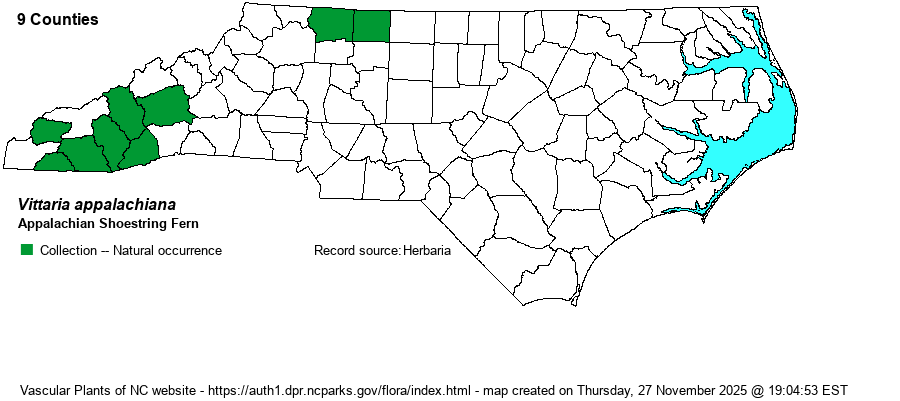| Author | Farrar & Mickel | |
| Distribution | Present in most of the southern Mountains, especially in the Escarpment Gorges area near the GA and SC boundaries. Also known from the Sauratown Mountains in the western Piedmont, from Surry and Stokes counties.
This is a primarily Appalachian species, ranging from NY and southern IN, south to northwestern SC and northeastern MS.
| |
| Abundance | Fairly common in the area from Macon County east to Transylvania County. Rare to uncommon elsewhere in the southern Mountains, and probably very rare to rare in the Sauratown Mountains. | |
| Habitat | This fern grows essentially only on damp and shaded rock faces, in grottoes. It may grow under the overhang of rock outcrops, or next to a waterfall in the spray zone. The rocks where it occurs are felsic ones such as gneiss and schist. |
| Phenology | Does not produce fruit. | |
| Identification | This is a gametophytic species, "reproducing vegetatively by gemmae, having lost the capability of producing sporophytes" (Weakley 2018). It has the appearance of a liverwort, with a branched pattern of tape-like green strips, one cell thick. "Dense colonies of Vittaria appalachiana coat rock surfaces in deeply sheltered habitats" (Flora of North America website). For a more detailed description, see the species account on that website. | |
| Taxonomic Comments | RAB (1968) mentions this unusual fern -- "A branching, ribbon-like gametophyte, with diffuse rhizoids and linear-shaped gemmae only one cell wide, of the genus Vittaria". Weakley (2018) notes: "Although this species has been known for some time (often referred to as the 'Appalachian Gametophyte'), it was only named formally relatively recently (Farrar & Mickel 1991)."
| |
| Other Common Name(s) | Appalachian Gametophyte | |
| State Rank | S3 | |
| Global Rank | G4 | |
| State Status | | |
| US Status | | |
| USACE-agcp | | |
| USACE-emp | | |

